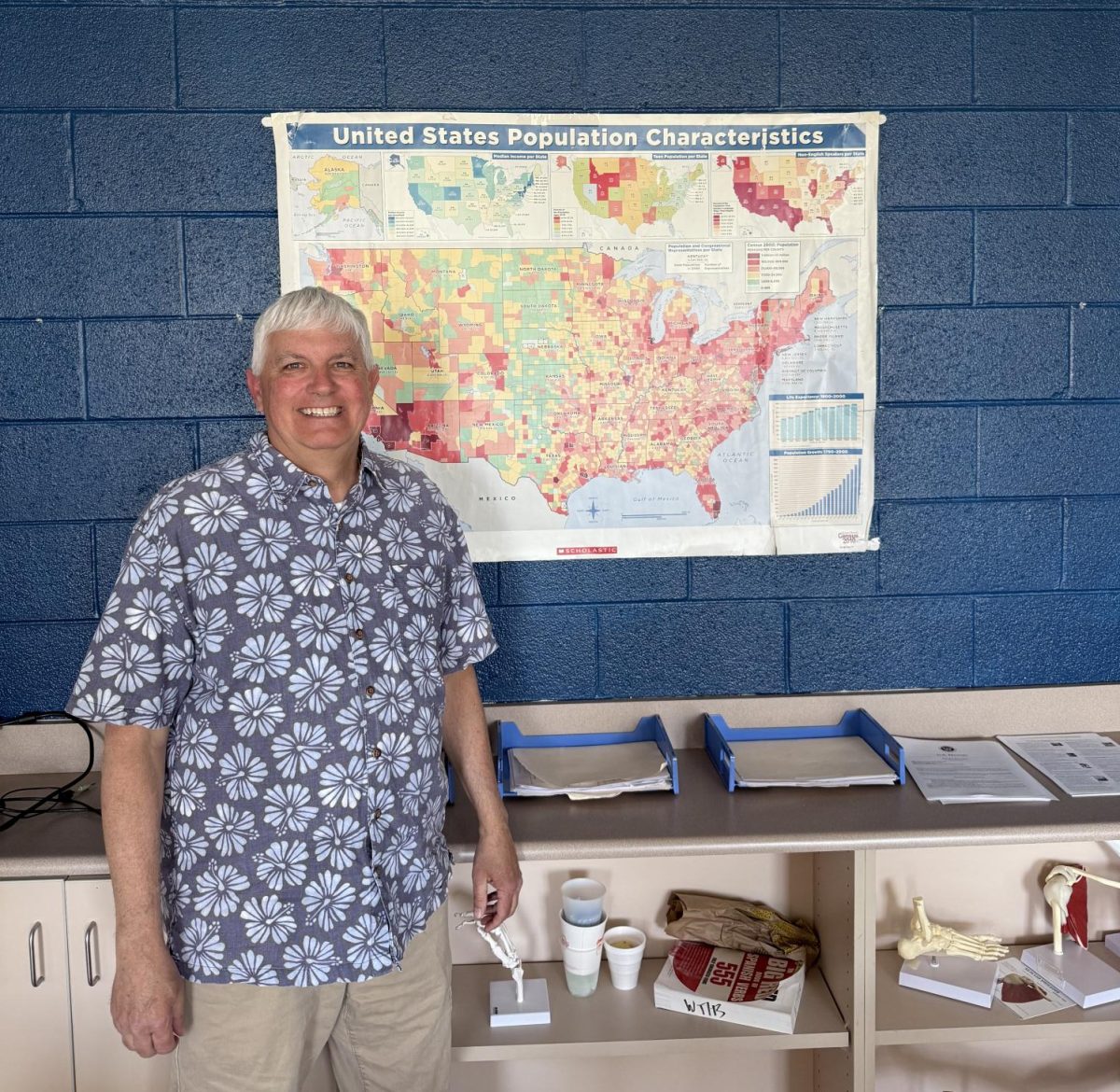A History of Crime In Relation To Serial Killers and School Shootings
March 24, 2023
“Here’s how easy it was to get away with bank robbery back in the ’30s — as long as you weren’t still there when the police arrived, you had a 99% chance of getting away with it”- John Mulaney.
There are very few undeniable facts when it comes to humanity, but violence existing since the beginning of humanity is prevalent throughout every version of history, from religious ideas to anthropological views. As history has progressed, many have sought to understand the rationale behind such violence. Although many people assume that violence, especially tragedies such as school shootings, can be attributed to one singular source, the truth is far more complex. While the biggest threat when it comes to mass murders, specifically school shootings, is misinformation and divisiveness, the biggest obstacle in solving serial murders is police incompetence, and even worse, indifference.
The month of April means a lot of things to various groups, including many extremist groups. The FBI siege of the Branch Davidian ended in Waco, Texas, the Oklahoma City bombing happened, and the Columbine High School Massacre occurred, taking place on April 20, 1999, changing the way that we view school shootings. To the Columbine Killers, the idea of their massacre being viewed as “one of the deadliest school shootings in American history” wouldn’t have horrified them. They wanted their names to be remembered, and they wanted their body count to be as high as possible. It wouldn’t have mattered to them that they stole the lives of 13 other people, or that they ruined the lives of hundreds, maybe even thousands of people. Their goal was to kill at the very least hundreds of people in what would have been known as the “greatest domestic terrorist attack in the United States”. In order to prioritize the legacy of the victims and survivors over those of the perpetrators, going forward, this essay will only refer to the victims and survivors by their names/aliases. The perpetrators will be referred to as either that or the “killers”, but never their real name, unless the killer’s name is instrumental to understanding their crimes. When the American public heard of the shooting that massacred 13 people, excluding the shooters, not to operate under the belief system morality determines what form of justice a person deserves, they jumped to two separate beliefs (Cullen). Both of these are, at least to an extent, incorrect. The two arguments take up two entirely different factions, one arguing that it was bullying of the so-called “Trench Coat Mafia” that led to the shooting, while the other faction believes that the tragedy cannot be explained, as the only people who know why this terrible event happened are already dead, having committed suicide before being questioned by authorities. Both of these rely on the idea that this was a spur of the moment event, and that this was not meticulously planned. The actual facts, however, contradict this narrative. Both the perpetrators had been planning this for months, perhaps even over a year, and they meticulously planned the event down to every minuscule detail. To contradict the original theory, however, according to Dave Cullen’s book Columbine, the perpetrators were well liked in the school. They were popular and had a circle of friends, enough that it would negate whatever harassment they might have faced by the “jocks” and “preps”. A small side note that further disproves the first argument is the fact that the perpetrators were not members of the Trench Coat Mafia, although there is debate about whether they were friends with some of the members (“Trench Coat Mafia”). The second argument is a little bit harder to disprove. After all, there is no way to learn every little detail about the massacre from anyone else’s words but their own. However, due to their meticulous planning, that also means that they left many notes and videos indicating why they did what they did, such as the Basement Tapes. As stated in their own manifesto’s, they didn’t do this out of a sense of righteousness, instead choosing to commit this mass atrocity in order to make an impact. Heavily influenced by the Oklahoma City bombings and Waco, both of which had a major event happen on April 19, they set off to commit what they hoped would top both of those in terms of casualties on April 19, 1999. However, as Dave Cullen mentions in his book, they didn’t have enough ammunition in order to comfortably carry out the attack, and so it was postponed a day to April 20, 1999, which coincidentally was also the date of Adolf Hitler’s birthday. This has led many people to falsely believe that this was a neo-Nazi attack, which probably was not according to the evidence accumulated to this date, although both of the perpetrators did, in fact, use neo-Nazi dog whistles, such as saying “Heil Hitler”. Although this paragraph has been slightly complicated, it does the best job that it can to spread light on the inaccuracies that follow school shootings.
The Columbine massacre happened in 1999, and although people were already divided on the issue of gun violence, the next two and a half decades would bring the matter to a breaking point. December 14, 2012 will go down in history as the day American children lost their innocence. Every generation has this moment, whether it be the September 11 attacks, the bombing of Pearl Harbor, etc. This was different, however. 26 children were murdered, shot to death, in the Sandy Hook Elementary School shooting. Whereas Columbine elicited undivided sympathy, the reaction to Sandy Hook was more divided. Take Alex Jones, the conspiracy theorist (Haag). He’s been an avid Sandy Hook conspiracy theorist, going as far as to call the survivors and families, even the victims, bad faith actors. This has caused the Sandy Hook survivors an immense amount of grief. To lose one’s child, some as young as 6-years old, and not be allowed to grieve, is cruel. It’s more than cruel, in fact. It’s inhumane. These shootings are not recent, all things considered. So let’s take it to Valentine’s Day of 2018, the day of the Stoneman Douglas High School shooting, also known as the Parkland shooting. This day can be called the turning point in the fight for gun control, as it brought more young people into the fight than possibly any other tragedy. The Parkland shooting highlighted the divides in the country when it came to gun control, with one side highlighting “violent video games” and “poor mental health” in opposition to the other side talking about sensible gun control laws. There’s no point in trying to change anyone’s mind, as this issue isn’t one based on hard data, instead being lodged in emotions. However, if one takeaway is taken from this, it should be that if the prelude to a school shooting is complex, the aftermath is far, far worse.
According to the FBI (“Serial Murder — FBI”), a mass murder is the murder of at least four people in the same incident with no “distinctive time period” between the murders. In opposition to this is the serial killer, which can be defined as so: The unlawful killing of two or more victims by the same offender(s), in separate events. These two definitions classify the vast majority of prolific killers, including but not limited to school shooters. Many people wrongly assume that school shooters are serial killers, but they’re not. They’re mass murderers, which might seem like an issue of semantics, but it’s actually so much more. The “profile”, for lack of better phrasing, of a serial killer is different than that of a mass murderer. According to the Department of Justice’s Office of Justice Programs(“Profiles in Terror – The Serial Murderer”), the average serial killer is a white man aged 25 to 34. Obviously, there are cases that don’t align with the profile, such as the DC Sniper Attacks, in which the perpetrators were two black men, one who was 41 and the other was 17. There is no public profile of the mass murderer, due to the diverse nature of the crimes, but there are some commonalities, such as childhood trauma and an “identifiable crisis point”(Peterson). That’s not to say that either of those things will make one a killer, instead they are simply things that could lead to a tragedy. The differences between mass murderers and serial killers are stark, but they have a few things in common, the key one being the complexity of the crimes.
Whitechapel District in London, England during the 1880s. What has become known as the Canonical Five, were the five victims of the unidentified serial killer with the moniker of Jack the Ripper(“A Brief History of the Jack the Ripper Murders”). Jack the Ripper was never caught, and his crimes became the starting point of what we know as modern day serial killers. The term “serial killer” was probably coined sometime after 1974 by FBI agent and profiler Robert Ressler(Bonn). Today, there are somewhere between 25 and 50 active serial killers in the United States at any given time, making it impossible to truly understand the scope of crime by delving into every single crime(“How Many Serial Killers Are On The Loose Today?”). In order to take this into account, a variety of different serial killers will be mentioned, such as the Milwaukee Cannibal and various other serial killers. The biggest threat, at least in the past, to the solving of serial murders, unlike mass murders where the problem lies in misinformation and divisiveness, is police incompetence. The Milwaukee Cannibal, also known as Jeffery Dahmer, killed a multitude of predominantly gay people of color in the Milwaukee area. He would kill, dismember, and then cannibalize his victims, which dubbed him the name of the “Milwaukee Cannibal”. Just like with the Columbine shooting, many people have tried to identify the failings in the system that led to Dahmer’s extensive killing spree. Many of the failings were that of the Milwaukee Police Department, with the police officers failing to investigate the severity of the crimes that Dahmer was committing, instead chalking it up to his homosexuality. This mistake would have a heavy price, the price of numerous young men who could have been saved had the police investigated a little deeper(Lancaster et al.). Many people have argued that the police did the best that they could have done, given the limited circumstances, this narrative is false, especially when it came to Konerak Sinthasomphone, a 14-year-old Latino boy who was one of Dahmer’s victims. After being tortured via acid being injected into his brain, he managed to escape, a feat of bravery that should be recognized. However, when the police arrived, Dahmer, who at this point was on probation for sexually assaulting someone, managed to convince the police that the boy was 19, and took him home, where he ended up being murdered. No follow up was done, and the sheer indifference towards this case is shocking, even for the time that these crimes took place in. Another case that showed shocking police incompetency is the case of the Zodiac Killer. Ironically, this man also has five canonical victims, although by his own account, he’s killed over 37 people. Not much is notable about the investigation of the Zodiac Killer, other than the widely agreed upon profile stating that this killer was a white man. After the Paul Stine murder, a white man matching the description was seen walking away from the crime scene. Even if this wasn’t the killer, and further writings from the Zodiac Killer would suggest otherwise, this man should have been brought in for investigation(Aldrick). Unfortunately, this man was allowed to walk into a park with no interference, and there has never been another known sighting of him in any Zodiac Killer writings. Even though one could argue that they let the man go due to the fact that the color of his skin didn’t match the description, this was still bad policing for two reasons. One, the original profile of the killer stated that he was a white man, meaning that they should have at least been looking out for people of both races. The second reason is more of a practical reason that doesn’t require any foresight. Any person who was walking away from the crime scene should have been investigated. Even when operating under the assumption that the man in question was not the Zodiac Killer, he could have provided crucial information. Many people have argued that police incompetency cannot be blamed for the lapse in time between the act of the crime being commited and the solving of the crimes, often pointing to the BTK Killer, or Dennis Rader. Rader was known for binding, torturing, and killing his victims, which gave him the name of BTK, of which there were ten victims spanning the course of three decades. He was eventually caught in 2005, when he asked the police if they could trace a floppy disk, before sending it to them. This led to the subsequent arrest of Rader, who was quite shocked that the police lied to him (Tikkanen). This was a smart move on the part of the police, however, it was only accomplished after the murders had ceased to occur. This means that even though this was a good decision on the part of the police, no lives were ultimately saved through this. Although the job of the police is incredibly difficult, police indifference and incompetency have led to most of the major failings when it comes to serial murders.
Serial killers and mass murderers have existed since the beginning of humanity. From a broader perspective, murder has existed since the beginning of time, spanning back all the way to Cain and Abel. However, there are things such as misinformation and divisiveness when it comes to mass murders and police incompetence and indifference when it comes to serial murders.
Works Cited
Aldrick, Amy. “Cold Case File: The Zodiac Killer — Forensic Science Society.” Forensic Science Society, 15 April 2022, https://forensicsciencesociety.com/thedrip/the-zodiac-killer. Accessed 22 February 2023.
Bonn, Scott. “Origin of the Term “Serial Killer.”” Psychology Today, 9 June 2014, https://www.psychologytoday.com/us/blog/wicked-deeds/201406/origin-the-term-serial-killer. Accessed 21 February 2023.
“A Brief History of the Jack the Ripper Murders.” Jack the Ripper, https://www.jack-the-ripper.org/jack-the-ripper-history.htm. Accessed 21 February 2023.
Cullen, Dave. “At last we know why the Columbine killers did it.” Slate, 20 April 2004, https://slate.com/news-and-politics/2004/04/at-last-we-know-why-the-columbine-killers-did-it.html. Accessed 21 February 2023.
Cullen, Dave. Columbine. Grand Central Publishing, 2010.
Haag, Matthew. “Sandy Hook Parents Sue Alex Jones for Defamation (Published 2018).” The New York Times, 17 April 2018, https://www.nytimes.com/2018/04/17/business/media/alex-jones-sandy-hook.html. Accessed 21 February 2023.
“How Many Serial Killers Are On The Loose Today?” World Atlas, 26 September 2022, https://www.worldatlas.com/articles/how-many-serial-killers-are-on-the-loose-today.html. Accessed 21 February 2023.
Lancaster, Joe, et al. “In Netflix’s ‘Dahmer,’ Incompetent Police Fail To Catch a Serial Killer.” Reason Magazine, 23 September 2022, https://reason.com/2022/09/23/in-netflixs-dahmer-incompetent-police-fail-to-catch-a-serial-killer/. Accessed 22 February 2023.
Peterson, Jillian. “Op-Ed: Nearly all mass shooters have 4 things in common.” Los Angeles Times, 4 August 2019, https://www.latimes.com/opinion/story/2019-08-04/el-paso-dayton-gilroy-mass-shooters-data. Accessed 21 February 2023.
“Profiles in Terror – The Serial Murderer.” Office of Justice Programs, https://www.ojp.gov/ncjrs/virtual-library/abstracts/profiles-terror-serial-murderer. Accessed 21 February 2023.
“Serial Murder — FBI.” FBI, https://www.fbi.gov/stats-services/publications/serial-murder#two. Accessed 21 February 2023.
Tikkanen, Amy. “Dennis Rader | Biography & Facts | Britannica.” Encyclopedia Britannica, 27 January 2023, https://www.britannica.com/biography/Dennis-Rader. Accessed 22 February 2023.
“Trench Coat Mafia.” a Columbine site, http://www.acolumbinesite.com/tcm.php. Accessed 21 February 2023.








